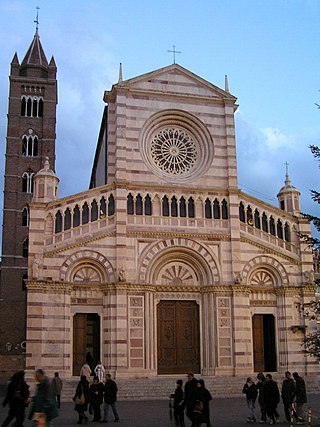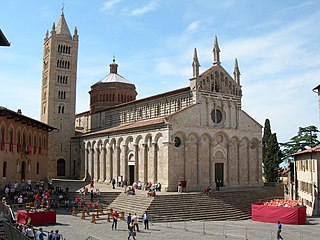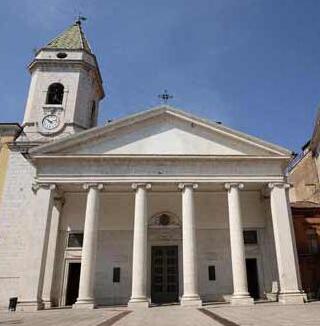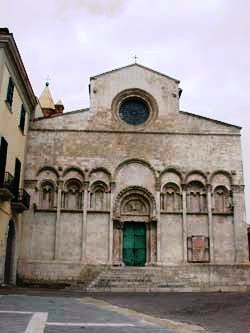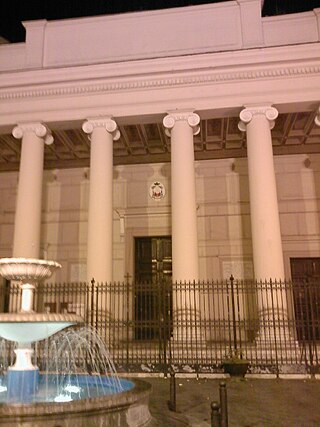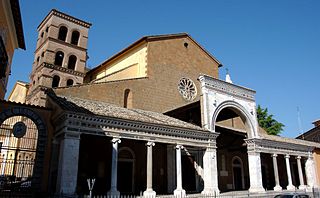History
The epoch of Bishop Benedict of Isernia, and indeed his very existence, is without any documentary evidence at all. It is even claimed that he had predecessors, beginning with Poltinus, who was consecrated a bishop by Saint Peter the Apostle himself. [3] That the existence of the episcopal see in the fifth century is certain is likewise a doubtful proposition; [4] each of the purported bishops has been assigned to other dioceses. [5]
After the Lombard invasions, Isernia was the seat of a countship, founded by the Duke of Benevento. It was destroyed by the Saracens in the ninth century. In 847, the entire city of Isernia was destroyed by an earthquake, with great loss of life, including the bishop. [6]
On 5 May 964, the Lombard princes, Pandulfus and Landulfus, granted the town of Isernia with all its territories to Count Landulfus, at the plea of Bishop Ardericus. The grant recites the boundaries of the territory. [7]
In 1199 it was sacked by Markward von Annweiler, the vicar of the deceased Emperor Henry VI. On 5 December 1456, another great earthquake caused heavy damage and deaths in the area of Isernia. [8] In 1688, both cities were damaged, though apparently the greatest damage was the loss of the church of the Carmelites in Venafro. [9] In 1805, Isernia was struck by a severe earthquake, which ruined the ancient cathedral. [10]
In 1032 the Diocese of Venafro (The town was formerly the site of Roman country residences) was united to Isernia, [11] and in 1230 it was again separated.
On 12 November 1192, the city of Venafro was sacked and burned by the German troops of the Emperor Henry VI, led by Duke Bertold. Bishop Gentile was forced to flee. He sought refuge in Aversa, whose leaders persuaded him to become their bishop. [12] The ecclesiastical leaders in Venafro and in Isernia immediately began to air various grievances against one another, which led to litigation. Numerous citations of the parties to appear before Cardinal Gerardo of S. Adriano, the judge whom Pope Celestine III had appointed, were ignored or put off to a later time. Exasperated, the cardinal authorized the chapter of the Cathedral at Venafro to proceed to elect their own bishop. [13] The Chapter elected Johannes de Abner, but when the pope heard that they had chosen someone who was not even in Holy Orders, he voided the election. [14] Finally, in 1195, he confirmed one R[ - - -] as the new bishop of Venafro. [15] Since the absence of a bishop at Isernia was causing great detriment, Pope Celestine appointed R., the bishop-elect of Venafro, to be the bishop of Isernia as well, ordering the Chapter to obey R. as if they had elected him themselves. [16]
Reorganization of the Kingdom of the Two Sicilies, 1818
Following the extinction of the Napoleonic Kingdom of Italy, the Congress of Vienna authorized the restoration of the Papal States and the Kingdom of The Two Sicilies (Naples). Since the French occupation had seen the abolition of many Church institutions in the Kingdom, as well as the confiscation of much Church property and resources, it was imperative that Pope Pius VII and King Ferdinand IV reach agreement on restoration and restitution.
A concordat was finally signed on 16 February 1818, and ratified by Pius VII on 25 February 1818. Ferdinand issued the concordat as a law on 21 March 1818. [17] The right of the king to nominate the candidate for a vacant bishopric was recognized, as in the Concordat of 1741, subject to papal confirmation (preconisation). [18] On 27 June 1818, Pius VII issued the bull De Ulteriore, in which he reestablished the metropolitan archbishopric of Capua, and assigned as suffragan (subordinate) dioceses: Isernia, Calvi, Suessa, and Caserta. The diocese of Venafro was permanently suppressed, and united to the diocese of Isernia. [19]
On 18 June 1852, in the bull "Sollicitudinem Animarum", Pope Pius IX the arrangement was changed. The diocese of Isernia and the revived diocese of Venafro were to be under the governance of one single bishop, aeque personaliter, to be called the diocese of Isernia e Venafro. [20]
Post Vatican II changes
Following the Second Vatican Council, and in accordance with the norms laid out in the council's decree, Christus Dominus chapter 40, [21] Pope Paul VI ordered a reorganization of the ecclesiastical provinces in southern Italy. His decree "Ad Apicem Spiritualis" of 21 August 1976 created a new episcopal conference in the region called "Molise", to be called "Boianensis-Campobassensis", with the archdiocese of Boiano-Campobasso, formerly directly subject to the Holy See, to be the Metropolitan; its suffragans were to be the dioceses of Trivento, Isernia e Venafra, and Thermulae e Larino. [22] Pope Paul VI also ordered consultations among the members of the Congregation of Bishops in the Vatican Curia, the Italian Bishops Conference, and the various dioceses concerned, with regard to additional changes.
On 18 February 1984, the Vatican and the Italian State signed a new and revised concordat. Based on the revisions, a set of Normae was issued on 15 November 1984, which was accompanied in the next year, on 3 June 1985, by enabling legislation. According to the agreement, the practice of having one bishop govern two separate dioceses at the same time, aeque personaliter, was abolished. The Vatican continued consultations which had begun under Pope John XXIII for the merging of small dioceses, especially those with personnel and financial problems, into one combined diocese.
On 30 September 1986, Pope John Paul II ordered that the dioceses of Isernia and Venafro be merged into full union as one diocese with one bishop, with the Latin title Dioecesis Aeserniensis-Venafrensis. The seat of the diocese was to be in Isernia, and the cathedral of Isernia was to serve as the cathedral of the merged diocese. The cathedral in Venafro was to become a co-cathedral, and its cathedral Chapter was to be a Capitulum Concathedralis. There was to be only one diocesan Tribunal, in Isernia, and likewise one seminary, one College of Consultors, and one Priests' Council. The territory of the new diocese was to include the territory of the suppressed diocese of Venafro. [23]




